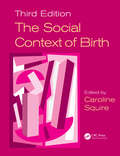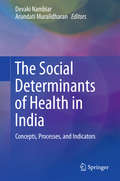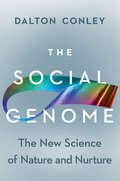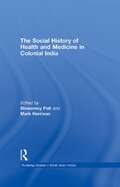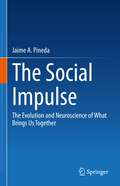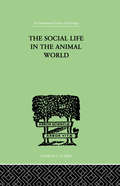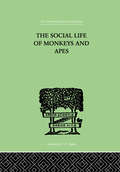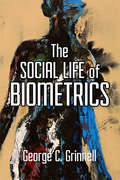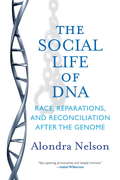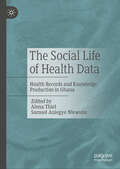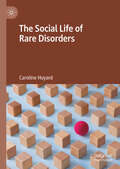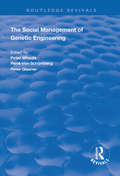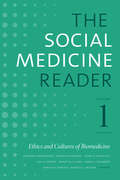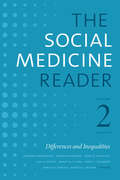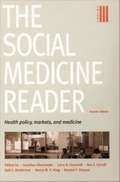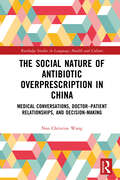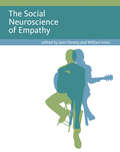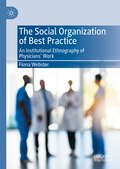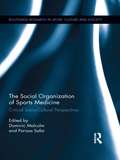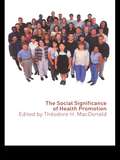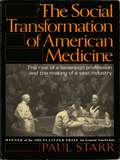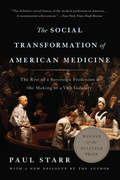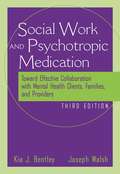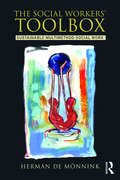- Table View
- List View
The Social Context of Birth
by Caroline SquireMidwives and other health care professionals need to have a deep understanding of the various lives childbearing women live in order to support them insightfully and practise in a nuanced manner. The Social Context of Birth has been revised, updated and enlarged to provide an essential understanding of the different lives women live and in which they birth their children. For the first time, it also contains original primary research on the perspectives of student midwives as they progress through their three year training. This comprehensive guide provides countless valuable insights into the many different lives, experiences and expectations of women in their childbearing years in the twenty-first century, especially vulnerable women. Written by a team of highly experienced health professionals, it also covers contentious areas of maternity care, such as new reproductive technologies and fetal surveillance. A true essential for all healthcare professionals who work with women giving birth, such as midwives, nurses, health visitors and obstetricians, and wish to deepen their knowledge of women’s lives.
The Social Determinants of Health in India
by Devaki Nambiar Arundati MuralidharanDrawing from the work of academics and practitioners from ten states across the country, this edited volume showcases and synthesises the diversity and richness of efforts to understand and act on the social determinants of health in India, the conditions in which we are born, grow, live work and age. Such an effort is salient in the current era of Sustainable Development Goals (SDG), which have foregrounded the issue of equity and the need for a comprehensive, multi-sectoral agenda for health and development. In India, particularly in the last decade, there have been myriad efforts to more critically theorise and intervene in areas with bearing on health, like conflict, nutrition or urbanisation, or to address the concerns of vulnerable groups like women, children and the elderly. From these efforts emerge lessons of convergence for academic and policymaking institutions in India who are looking to operationalise and bring life to the SDG agenda in India and other Low and Middle Income Country settings. The book comprises eleven chapters and six short commentaries that appear in conversation with each other, as well as an annexure of validated, ready-to-use indicators for monitoring of social determinants of health.
The Social Genome: The New Science of Nature and Nurture
by Dalton ConleyA pioneering scientist presents a mind-expanding account of the sociogenomics revolution, which promises to upend everything we know about human development. For more than 150 years, the question of nature versus nurture has been one of the most contentious issues in the human sciences. On the one side are “blank-slaters,” who believe we are mainly shaped by our environment. On the other side are “hereditarians,” who believe in the primacy of genes. From the start, the fight has been highly politicized and extremely bitter, given that it has implications for how we think about racial disparities, meritocracy, reproduction, and free will itself. In The Social Genome, pioneering scientist Dalton Conley demonstrates that this longstanding debate is fundamentally misguided. The true question is not nature versus nurture, but how nature and nurture interact to make each of us who we become. The Social Genome is a sweeping account of the sociogenomics revolution, which has, in the last decade, upended many of our notions about human development. Sociogenomics brings together advances in molecular genetics and traditional social and behavioral science. The key tool is the polygenic index, which allows us to analyze DNA to measure a child’s genetic potential. Today, we can estimate a child’s adult height, how far they will go in school, and their weight as an adult—all from a cheek swab, finger prick, or vial of saliva. Conley and other researchers are using this new science to shed light on the ways in which genes shape our world, influencing how each person both creates and responds to the environment around them. Conley reveals a world where children’s DNA influences the nurture they extract from their parents; the genes of our schoolmates affect our likelihood of smoking as much as our own DNA does; and spouses’ genes influence each other’s moods and behaviors. Looking forward, Conley envisions a future where dating, education, public health, and other institutions have been radically altered by the sociogenomic revolution. As Conley argues, we should no longer think of nature versus nurture, but about how our genes seek the nurture they need to express themselves and how, in turn, our environments are made partly from the genes of other people. The Social Genome presents a nuanced, powerful perspective on individual potential and social dynamics and raises critical ethical questions about how we will navigate a future where we have access to far more genetic information than ever before.
The Social History of Health and Medicine in Colonial India (Routledge Studies in South Asian History)
by Mark Harrison Biswamoy PatiThis book analyzes the diverse facets of the social history of health and medicine in colonial India. It explores a unique set of themes that capture the diversities of India, such as public health, medical institutions, mental illness and the politics and economics of colonialism. Based on inter-disciplinary research, the contributions offer valuable insight into topics that have recently received increased scholarly attention, including the use of opiates and the role of advertising in driving medical markets. The contributors, both established and emerging scholars in the field, incorporate sources ranging from palm leaf manuscripts to archival materials. This book will be of interest to scholars of history, especially the history of medicine and the history of colonialism and imperialism, sociology, social anthropology, cultural theory, and South Asian Studies, as well as to health workers and NGOs.
The Social Impulse: The Evolution and Neuroscience of What Brings Us Together
by Jaime A. Pineda, Ph.D.This book is an exploration of the integration-differentiation dynamics that result in a drive, or impulse, toward human sociality, arguing that our need to connect with other people is as fundamental as our need for food and shelter. In The Social Impulse: The Evolution and Neuroscience of What Brings Us Together, Jaime Pineda presents the evidence that social cohesion is a complementary force to natural selection, the Darwinian drive for differentiation and diversity. The book addresses the distinctive aspects of social behavior that arise from integration principles and seeks to answer the following questions: (1) Why does social cohesion arise? (2) What is the history of social dynamics? (3) How does social cohesion work? (4) When do the developmental aspects of social dynamics arise? A final section of the book addresses the value of sociality and social cohesion. By exploring the differences, similarities, and, most important, the interactivity between natural selection and social cohesion, this unique book provides a wealth of interesting, challenging, and unexpected insights.
The Social Life In The Animal World
by Alverdes, FrFirst Published in 1999. Routledge is an imprint of Taylor & Francis, an informa company.
The Social Life Of Monkeys And Apes (International Library Of Psychology Ser.)
by Zuckerman, SFirst Published in 1999. Routledge is an imprint of Taylor & Francis, an informa company.
The Social Life of Biometrics
by George C GrinnellIn The Social Life of Biometrics, biometrics is loosely defined as a discrete technology of identification that associates physical features with a legal identity. Author George Grinnell considers the social and cultural life of biometrics by examining what it is asked to do, imagined to do, and its intended and unintended effects. As a human-focused account of technology, the book contends that biometrics needs to be understood as a mode of thought that informs how we live and understand one another; it is not simply a neutral technology of identification. Placing our biometric present in historical and cultural perspective, The Social Life of Biometrics examines a range of human experiences of biometrics. It features individual stories from locations as diverse as Turkey, Canada, Qatar, Six Nations territory in New York State, Iraq, the skies above New York City, a university campus and Nairobi to give cultural accounts of identification and look at the ongoing legacies of our biometric ambitions. It ends by considering the ethics surrounding biometrics and human identity, migration, movement, strangers, borders, and the nature of the body and its coherence. How has biometric thought structured ideas about borders, race, covered faces, migration, territory, citizenship, and international responsibility? What might happen if identity was less defined by the question of “who’s there?” and much more by the question “how do you live?”
The Social Life of DNA
by Alondra NelsonThe unexpected story of how genetic testing is affecting race in AmericaWe know DNA is a master key that unlocks medical and forensic secrets, but its genealogical life is both revelatory and endlessly fascinating. Tracing genealogy is now the second-most popular hobby amongst Americans, as well as the second-most visited online category. This billion-dollar industry has spawned popular television shows, websites, and Internet communities, and a booming heritage tourism circuit.The tsunami of interest in genetic ancestry tracing from the African American community has been especially overwhelming. In The Social Life of DNA, Alondra Nelson takes us on an unprecedented journey into how the double helix has wound its way into the heart of the most urgent contemporary social issues around race.For over a decade, Nelson has deeply studied this phenomenon. Artfully weaving together keenly observed interactions with root-seekers alongside illuminating historical details and revealing personal narrative, she shows that genetic genealogy is a new tool for addressing old and enduring issues. In The Social Life of DNA, she explains how these cutting-edge DNA-based techniques are being used in myriad ways, including grappling with the unfinished business of slavery: to foster reconciliation, to establish ties with African ancestral homelands, to rethink and sometimes alter citizenship, and to make legal claims for slavery reparations specifically based on ancestry.Nelson incisively shows that DNA is a portal to the past that yields insight for the present and future, shining a light on social traumas and historical injustices that still resonate today. Science can be a crucial ally to activism to spur social change and transform twenty-first-century racial politics. But Nelson warns her readers to be discerning: for the social repair we seek can't be found in even the most sophisticated science. Engrossing and highly original, The Social Life of DNA is a must-read for anyone interested in race, science, history and how our reckoning with the past may help us to chart a more just course for tomorrow.From the Hardcover edition.
The Social Life of Health Data: Health Records and Knowledge Production in Ghana
by Alena Thiel Samuel Aniegye NtewusuThis book takes the contemporary moment of digital health infrastructuring in Ghana as a starting point to examine the genealogies of oral, paper-based and digital forms of knowledge production about health. In view of this multiplicity of forms, the chapters adopt a broad definition of health data that encompasses databases, statistics as well as oral and written records and reports about health. In addition to close historiographic insights into the interactions of indigenous and colonial ways of organising knowledge around health, the chapters explore contemporary ways in which medical professionals are mobilized or potentially demobilized by the standards, methods and calculative devices that accompany the increasing production of health data. The authors show that the contemporary hype around the datafication of health is neither new nor exceptional, but instead needs to be read in broader historical perspective. Through its unique combination of historical, sociological and ethnographic methods, the book shows that the regulation and standardization of health produces both mobilizations and demobilizations, as well as appropriations and resistances.
The Social Life of Rare Disorders
by Caroline HuyardThis book is the first comprehensive study of rare disorders from a historical, political, and social perspective. It is estimated that around 300 million people worldwide live with a rare disorder today. What do patients and associations concerned by one of the 7,000 known rare diseases have in common, and what does rarity mean to them? How did rare disorders become a mainstream category in public health policy? To answer these questions, Caroline Huyard traces the history, over more than 50 years, of medical treatments for one particular disease, and that of the orphan drug status in the United States and in Europe. The book shows that public authorities had a much greater role than biomedicine in turning rare disorders into a public health problem. A comparison of patients' experiences of 6 rare diseases as well as the activities of 8 associations in France underlines the importance of isolation and care for patients on the one hand, and the role of stakeholders’ participation for associations on the other hand. This book is essential reading for researchers and students interested in contemporary healthcare systems and topics related to public policies on emerging issues, the industrialisation and regulation of medicine, the concept of care, and the governance of patient organisations.
The Social Management of Genetic Engineering (Routledge Revivals)
by Peter Wheale René von SchombergFirst published in 1998, this volume why and how genetic engineering has emerged as the technology most likely to change our lives, for better or worse, in the opening century of the third millennium. Over twenty international experts, including moral philosophers and social scientists, describe the issues and controversies surrounding modern biotechnology and genetic engineering. They explore ways in which lay individuals and groups can join in an effective and constructive dialogue with scientists and industrialists over the assessment, exploitation and safe management of these new and important technologies. Topics covered include a discussion of the issues surrounding ‘Dolly’, the cloned sheep, the politics and ethics of the international research programme to sequence the entire human genome, the ethical questions raised by the creation of transgenic farm animals, the morality of genetic experimentation on animals, the controversy surrounding the patenting of genetic material and of the transgenic animals themselves, the ethical implications of engineering animals for transplanting their organs into humans, and the environmental hazards of releasing genetically engineered organisms.
The Social Medicine Reader, Volume I, Third Edition: Ethics and Cultures of Biomedicine
by Sue E. Estroff Jonathan Oberlander Larry R. Churchill Ronald P. Strauss Mara Buchbinder Nancy M. King Barry F. Saunders Rebecca L. WalkerThe extensively updated and revised third edition of the bestselling Social Medicine Reader provides a survey of the challenging issues facing today's health care providers, patients, and caregivers by bringing together moving narratives of illness, commentaries by physicians, debates about complex medical cases, and conceptually and empirically based writings by scholars in medicine, the social sciences, and the humanities. Volume 1, Ethics and Cultures of Biomedicine, contains essays, case studies, narratives, fiction, and poems that focus on the experiences of illness and of clinician-patient relationships. Among other topics the contributors examine the roles and training of professionals alongside the broader cultures of biomedicine; health care; experiences and decisions regarding death, dying, and struggling to live; and particular manifestations of injustice in the broader health system. The Reader is essential reading for all medical students, physicians, and health care providers.
The Social Medicine Reader, Volume II, Third Edition: Differences and Inequalities
by Sue E. Estroff Jonathan Oberlander Larry R. Churchill Ronald P. Strauss Mara Buchbinder Nancy M. King Barry F. Saunders Rebecca L. WalkerThe extensively updated and revised third edition of the bestselling Social Medicine Reader provides a survey of the challenging issues facing today's health care providers, patients, and caregivers with writings by scholars in medicine, the social sciences, and the humanities.
The Social Medicine Reader: Health Policy, Markets, and Medicine
by Sue E. Estroff Jonathan Oberlander Larry R. Churchill Gail E. Henderson Nancy M. P. King Ronald P. StraussDuke University Press is pleased to announce the second edition of the bestselling Social Medicine Reader. The Reader provides a survey of the challenging issues facing today's health care providers, patients, and caregivers by bringing together moving narratives of illness, commentaries by physicians, debates about complex medical cases, and conceptually and empirically based writings by scholars in medicine, the social sciences, and the humanities. The first edition of The Social Medicine Reader was a single volume. This significantly revised and expanded second edition is divided into three volumes to facilitate use by different audiences with varying interests.
The Social Nature of Antibiotic Overprescription in China: Medical Conversations, Doctor–Patient Relationships, and Decision-Making (Routledge Studies in Language, Health and Culture)
by Nan Christine WangOffering a rarely seen glimpse into the realities of one of the biggest global public health crises in modern time, Wang’s book focuses on doctor–patient interactions in China to demonstrate the potential effects of health communication, doctor–patient relationship, and a matrix of social factors on overprescription of antibiotics.Based on a community-based survey, the book describes empirical findings regarding the high prevalence of non-prescribed antibiotics use for common colds among children in China. It covers the potential effects of overprescription on caregivers' attitudes and how physicians make prescribing decisions in medical consultations. Drawing from evidence in medical interaction data, readers are introduced to further empirical findings regarding the communicative behaviors that patient caregivers use to pressure for antibiotic prescriptions in real medical consultations. Following this, Wang reports findings regarding the communicative behaviors that physicians use to make treatment recommendations and caregivers use to launch treatment negotiations, leading to a discussion of the effect of the doctor–patient relationship on antibiotic overprescription. The book culminates in practice recommendations and provides teaching scenarios in which physicians successfully engage the caregivers into conversations to shape their expectations for antibiotic prescriptions in medical consultations.An important resource for scholars and students in health communication, linguistics, medical humanities, and medical sociology. Practitioners who are interested in understanding and improving clinical practices as well as policymakers aiming to combat antibiotic resistance will also find this book useful.
The Social Neuroscience of Empathy (Social Neuroscience)
by Jean Decety William IckesCross-disciplinary, cutting-edge work on human empathy from the perspectives of social, cognitive, developmental and clinical psychology and cognitive/affective neuroscience.In recent decades, empathy research has blossomed into a vibrant and multidisciplinary field of study. The social neuroscience approach to the subject is premised on the idea that studying empathy at multiple levels (biological, cognitive, and social) will lead to a more comprehensive understanding of how other people's thoughts and feelings can affect our own thoughts, feelings, and behavior. In these cutting-edge contributions, leading advocates of the multilevel approach view empathy from the perspectives of social, cognitive, developmental and clinical psychology and cognitive/affective neuroscience. Chapters include a critical examination of the various definitions of the empathy construct; surveys of major research traditions based on these differing views (including empathy as emotional contagion, as the projection of one's own thoughts and feelings, and as a fundamental aspect of social development); clinical and applied perspectives, including psychotherapy and the study of empathy for other people's pain; various neuroscience perspectives; and discussions of empathy's evolutionary and neuroanatomical histories, with a special focus on neuroanatomical continuities and differences across the phylogenetic spectrum. The new discipline of social neuroscience bridges disciplines and levels of analysis. In this volume, the contributors' state-of-the-art investigations of empathy from a social neuroscience perspective vividly illustrate the potential benefits of such cross-disciplinary integration.ContributorsC. Daniel Batson, James Blair, Karina Blair, Jerold D. Bozarth, Anne Buysse, Susan F. Butler, Michael Carlin, C. Sue Carter, Kenneth D. Craig, Mirella Dapretto, Jean Decety, Mathias Dekeyser, Ap Dijksterhuis, Robert Elliott, Natalie D. Eggum, Nancy Eisenberg, Norma Deitch Feshbach, Seymour Feshbach, Liesbet Goubert, Leslie S. Greenberg, Elaine Hatfield, James Harris, William Ickes, Claus Lamm, Yen-Chi Le, Mia Leijssen, Abigail Marsh, Raymond S. Nickerson, Jennifer H. Pfeifer, Stephen W. Porges, Richard L. Rapson, Simone G. Shamay-Tsoory, Rick B. van Baaren, Matthijs L. van Leeuwen, Andries van der Leij, Jeanne C. Watson
The Social Organization of Best Practice: An Institutional Ethnography of Physicians’ Work
by Fiona WebsterThis book explores how best practice for acute stroke care was developed, translated and taken up in medical practice across various sites in the province of Ontario using institutional ethnographic research. Institutional ethnography, an approach developed by Dorothy E. Smith, builds on Smith’s understanding of the social organization of knowledge, allowing for an examination of the complex social relations organizing people’s experiences of their everyday working lives. This work thereby makes visible some of the assumptions and hidden priorities underlying the emphasis given to translating scientific knowledge into medical practice. In this study, the discourses of both evidence-based medicine and knowledge translation, purportedly designed to improve patient care, come into view as managerial tools that directed healthcare resources toward academic hospitals rather than community sites where the majority of patients receive care. These models institutionalize inequities in access to care while claiming to resolve them.
The Social Organization of Sports Medicine: Critical Socio-Cultural Perspectives (Routledge Research in Sport, Culture and Society)
by Parissa SafaiThe Social Organization of Sports Medicine is the first book-length overview of the social scientific study of sports medicine, drawing together work from an international cadre of scholars who examine and provide interdisciplinary analysis of the dynamic and multi-faceted relationships between sports and medicine and within sports medicine. The book charts changing perceptions of sport within medical discourse, attempts by sports medicine providers to forge professional identities in response to these processes, the day-to-day experiences of deliverers of sports medicine and the reactions of recipients of that healthcare. The contents are organized in four sections, examining the competing and changing ways in which sports medicine is conceived, the ways in which it is organized, the ways in which it is practiced, and points of contestation between traditional and alternative and emerging forms of (sports) medicine. This collection of essays consolidates recent advances in this area of study and establishes a basis for the future development of the field.
The Social Significance of Health Promotion
by Théodore H. MacDonaldThe Social Significance of Health Promotion sets health promotion in its historical context and delineates its contemporary role. It explores the potential of health promotion to impact on our social values and sense of community. The book begins by exploring the historical roots of health promotion and its relationship to the medical model of health. It moves on to present analyses of contemporary health promotion programmes in which the contributors are actively engaged. These chapters discuss current questions for health promotion from a practitioner perspective and from the point of view of their social impact. They cover a wide range of topical issues such as exclusion and inclusion, the mental health of children, the role of alternative medicine, and health in the workplace.Emphasising the centrality of empowerment, participation and advocacy to an effective health promotion programme, The Social Significance of Health Promotion brings students and health professionals right up to date with the latest initiatives and theories.
The Social Sources of Adjustment to Blindness
by Irving Faber Lukoff Martin WhitemanThe impact of society on the blind is a complex issue, and many different tacks are necessary even if we are to only make little headway through the eddies and currents that alter and modify people's lives. This study is focused on the social forces that influence the adaptation of blind persons. The information derives from almost 500 interviews with blind persons selected from all walks of life.
The Social Transformation Of American Medicine: The Rise Of A Sovereign Profession And The Making Of A Vast Industry
by Paul StarrWinner of the 1983 Pulitzer Prize and the Bancroft Prize in American History, this is a landmark history of how the entire American health care system of doctors, hospitals, health plans, and government programs has evolved over the last two centuries. "The definitive social history of the medical profession in America. . . . A monumental achievement. "--H. Jack Geiger, M. D. , New York Times Book Review
The Social Transformation of American Medicine: The Rise of a Sovereign Profession and the Making of a Vast Industry
by Paul StarrWinner of the 1983 Pulitzer Prize and the Bancroft Prize in American History, this is a landmark history of how the entire American health care system of doctors, hospitals, health plans, and government programs has evolved over the last two centuries. "The definitive social history of the medical profession in America....A monumental achievement."-H. Jack Geiger, M.D., New York Times Book Review
The Social Worker and Psychotropic Medication: Toward Effective Collaboration with Mental Health Clients, Families, and Providers (3rd edition)
by Joseph Walsh Kia J. BentleyIntended for social workers who want to understand the drugs prescribed to their clients, this text describes the central nervous system, the basic principles of pharmacology, and the specific disorders treated by antipsychotics, antidepressants, mood stabilizers, anti-anxiety drugs, and psychostimulants. The third edition reflects new medications and new uses of medications across diagnostic categories.
The Social Workers' Toolbox: Sustainable Multimethod Social Work
by Herman de MönninkThe Social Workers' Toolbox aims to bring order to the diversity of tools which are so characteristic of social work: assessment tools, practice tools and outcome-measurement tools. The tools described in this Toolbox can be directly put into practice and adapted to the social workers’ personalized approach with their individual clients and their environments. The underlying meta-theory for Sustainable Multimethod Social Work is the ‘PIE-Empowerment Theory’. This theory defines social work practice in terms of the partnership between social worker and client and is aimed at enhancing quality of life through systematically and sustainably addressing human needs and human rights. The multimethod model promotes the flexible combination of well-written evidence- and practice-based tools. Packed full of useful checklists, the Toolbox is ideal reading for both inexperienced and more practiced social workers. The book provides a solid basis through the use of practical examples. For the more experienced social worker it offers a substantial resource and the means to legitimize a chosen course of action and social work intervention. Schools of social work will be able to use the book as an easily accessible resource for social work assessments, interventions and quality social work management.
